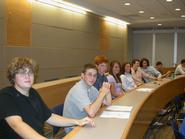
While the large MERCURY conference was going on next door, another, smaller group of students also met at Hamilton for a science conference. This was the Colgate-Hamilton Organic Group conference, the creation of four professors at the two institutions for their organic chemistry students.
The conference is roughly 10 years old. It came into existence when the Silas D. Childs Professor of Chemistry Robin Kinnel broached the subject to Colgate's Professor John Cochran. Kinnel wanted to bring research students together for a symposium. Cochran, who has since retired, put Kinnel in touch with Colgate professor Ernie Nolan and the two professors worked out what would become the CHOG conference.
The name (as it appears, "chalk" or "chawg," depending on how well you enunciate your word endings) is an important point in the history of the conference. Since Kinnel had proposed the idea, he felt that the name proposed by Hamilton should prevail. Unfortunately, he could not think up any good names to describe the summer symposium. Nolan offered "Colgate-Hamilton Organic Group" as a stop-gap, and the name stuck; the conference became, unalterably, CHOG.
The group meets most summers; Kinnel estimates that they have met eight times in the past 10 years, alternating host privileges between the schools. Since the beginning, it has always been an afternoon of talks followed by a group meal. Kinnel feels that this is evidence of a spirit of academic cooperation between the two schools. Certainly it gives the students the opportunity to share their research with a wider audience, which was Kinnel's intention when he began the conference.
Over the years, there have been few changes. What "evolution" has occurred has been two-fold. Kinnel, and Ian Rosenstein, associate professor of chemistry, the other Hamilton organizer, see a slight increase in the number of participating students, although this is due more to the movements in the departments than to any larger trend. There is also more mixing between the representative students, which clearly pleases both professors. Kinnel recalls one year where the Colgate students stayed at Hamilton watching movies until midnight.
From the students' end, CHOG is a taste of a professional conference. They each assemble a power-point presentation about their research and give a 15-minute talk and question session in one of the Science Center lecture halls. The preparation is entirely in their own hands and most do their presentations without asking their professors for help. This kind of formal presentation is as much part of what a scientist does as 10 weeks of lab research, and it gives the students the "conference" experience to go with the "lab" one.
It is, however, a low-key taste. Where the MERCURY presenters came out of their session giddy and nervous (one student claimed to not remember what he said), the CHOG students seemed comfortable at their break. Philip Milner, one of two members of the Class of 2010 presenting, said he found the experience a "little scary," but much like giving a presentation in high school. Everyone agreed that things went well.
David Brown '10 ducked the camera to a few giggles and some Colgate students joked with a few Hamiltonians about the lack of cookies. Rosenstein moved some files on the computer and everybody wandered back to their seats. Break was over without really being announced, and, without further ado, it was time for Colgate's Becky Greaves to speak. Not too formal, not too scary and, most important, not too professionally-focused. As Kinnel put it, "the show is the students."
-- by Lisbeth Redfield
Posted August 3, 2006
